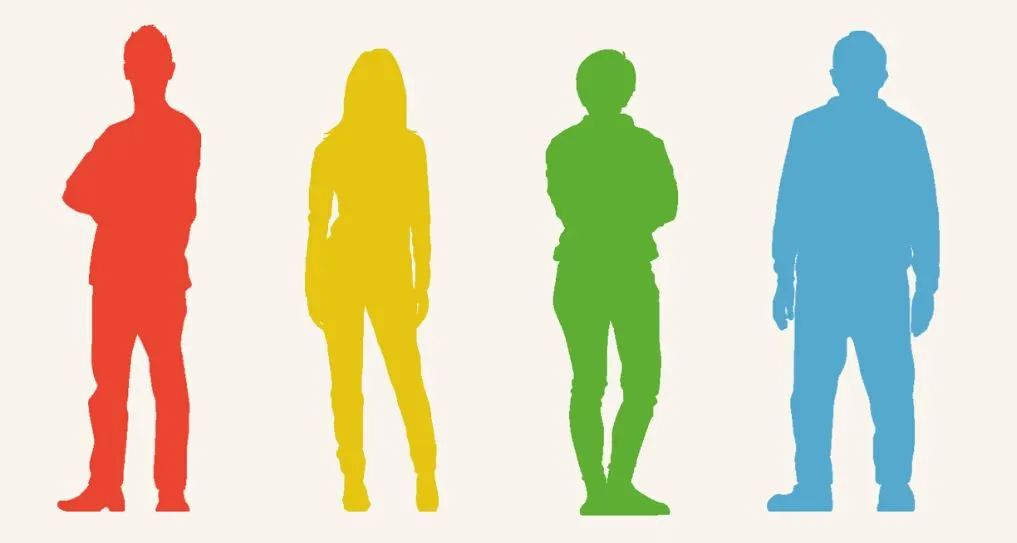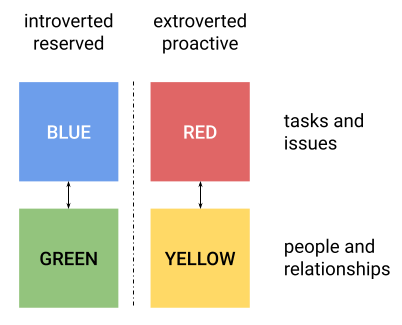Four-colour personality types
Navigating Complex Interactions: Using Erikson's Personality Types to Improve Communication and Empathy.

Interacting with people can be complex and doesn't always come naturally. According to Thomas Erikson, there are four personality types: Red, yellow, blue, and green. Thanks to Erikson's personality types, I now have some new tools to develop more empathic relationships, even with people who have different personalities than mine.
I often find myself needing to understand the point of view of others (employees, clients, colleagues, friends, family members, etc.). My goal is to adapt my communication style and change my perspective (which does not necessarily mean changing my opinion or theirs). Sometimes this is easy, but other times it's not. When this happens, I wonder: Why is that? Am I not empathic enough? Could the misalignment be related more to our personalities than the content of the message? For example, the other people and I involved in a discussion agree that there is a problem and define a solution we want to pursue to solve it. But, we are facing challenges in implementing it because we can't agree on its main steps. In this situation, we agree on the problem and the solution, but we are stuck on the action. Could it be that the practical implementation relates to our personality types?
During these kinds of experiences, I noticed that there are patterns, mostly related to biases and "characters." Therefore, I searched for a simple classification to have an actionable interpretation in such situations. Logical categorisation does not mean making black-or-white choices, but rather considering a possible finite set of plausible solutions to enhance communication and simplify the process without manipulation.
Within the scope of my research, I stumbled upon the work of Thomas Erikson, a Swedish communication and leadership expert, author, and speaker. He has developed a model of personality types based on the colours red, yellow, green, and blue, which he discusses in his book "Surrounded by Idiots: The Four Types of Human Behavior and How to Effectively Communicate with Each in Business (and in Life)." In summary, the four types are:
Red: assertive, decisive, dominant, ambitious, competitive, and hot-tempered. People with a red personality drive themselves with power and confidently make decisions. They do not have issues speaking their minds and usually revolt against traditional ways of doing things.
Yellow: spontaneous, fun-loving, energetic, sanguine, cheerful, confident, optimistic, and charming. People with a yellow personality are creative and enjoy taking risks. They can talk a mile a minute and sometimes answer unasked questions.
Green: analytical, logical, calm, phlegmatic, balanced, friendly, and tolerant. People with a green personality are detail-oriented and disciplined in their work. They are good listeners and do not like the spotlight or create conflicts.
Blue: empathetic, sensitive, compassionate, melancholic, perfectionist, and realist (pessimist). People with a blue personality are caring and considerate of others' feelings. They usually keep their thoughts to themselves and prefer to analyze situations silently. For them, silence is a virtue and they speak only on important occasions.
A person's personality can be a mix of reds and yellows or greens and blues (other kinds of interactions are possible but rare and depend mostly on behaviour rather than on who we are). This schema summarises the characteristics and interactions:
 I consider myself to have both green and blue personality traits. The green traits are my definite strengths, while some of the blue traits are related to some of my limiting beliefs (such as perfectionism and realism), but also contribute to enriching my personality (such as compassionate and empathetic behaviour). I can say that I was born with green traits, but through my life experiences, I have acquired some blue behaviours, both for the better and the worse. My secondary objective is also to acquire some useful traits from reds and yellows and apply their behaviours when important and necessary.
I consider myself to have both green and blue personality traits. The green traits are my definite strengths, while some of the blue traits are related to some of my limiting beliefs (such as perfectionism and realism), but also contribute to enriching my personality (such as compassionate and empathetic behaviour). I can say that I was born with green traits, but through my life experiences, I have acquired some blue behaviours, both for the better and the worse. My secondary objective is also to acquire some useful traits from reds and yellows and apply their behaviours when important and necessary.
Understanding my personality and that of the people I interact with has had several benefits:
I better understand my general approach to life and how I interact with others (what I express to them through my personality).
I have a greater understanding of others and have significantly reduced my frustrations because I can communicate better and understand the foundations of other people's reactions (which are also driven by their personalities).
I can now work on acquiring new, positive, and enriching traits from other personality types. For example, the decisiveness and assertiveness of reds or the confidence, optimism, and spontaneity of yellows.
From my point of view, the four colours are a simplistic approach to categorizing people, but they can be very practical and actionable in certain contexts. I don't always try to map people into their corresponding colours. I only use this approach to change my perspective or processes when I need to solve an issue or problem through more effective communication. What colour are you? And how would you use the classification in your day to day?